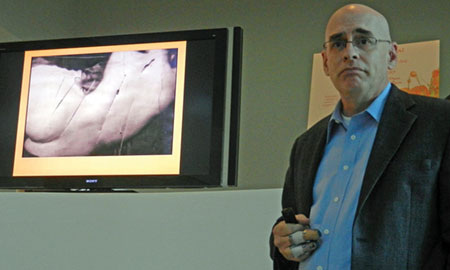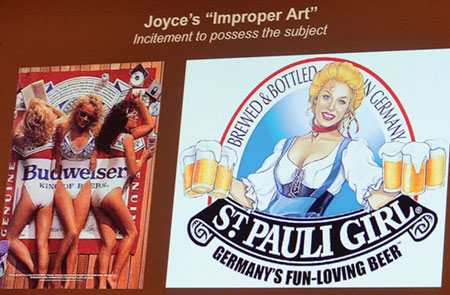
Pornography is subjective. While one person may find nudity in any form pornography, another may see it as art but find crude language pornographic. During the Triton Museum of Art’s final lecture in the At the Edge of Art History series, Chief Curator Preston Metcalf tried to define pornography and give specific examples of art that has been deemed pornographic in the past.
“The standing definition [of pornography] from Webster’s Dictionary is, ‘the depiction of erotic behavior,'” said Metcalf. “That could be absolutely anything…Laws turn on this definition.”
Under this definition, great works of literature like “The Catcher in the Rye,” “The Diary of Anne Frank,” and “Ulysses” have been called pornography. Almost yearly, someone, somewhere tries to get books banned based on what they see as pornographic text, but Webster’s vague definition leads to an even more undefined explanation of pornography.
“There’s a second definition for pornography and a lot of works have been banned under this definition,” said Metcalf. “It’s even more ambiguous than the first: ‘The depiction of acts in a sensational manner so as to arouse a quick reaction.’ So, under this definition, in Cincinnati a book was banned, not because it aroused a quick reaction in a sensational manner. The book that was banned…[was] Huckleberry Finn by Mark Twain…because Mark Twain wrote in the idiom and vernacular of the rural deep south.”
Michelangelo’s “The Creation of Adam” was declared pornographic, not because Adam was nude, but because Adam was painted with a navel – something that he wouldn’t have. “The Last Judgement,” also by Michelangelo, was determined to be so crude that, after his death, an artist was called in to paint drapes over many of the figures. Would these pieces still be considered pornography today?

“I’ve seen a lot of definitions for pornography,” said Metcalf. “The best definition I have ever seen comes from James Joyce…He says there is proper art and there is improper art. Improper art comes in two kinds. The first kind of improper art is art that entices you to possess the subject. This he calls pornography…If you’re looking at a nude and you can look at that nude or that subject matter or that couple or whatever it may be and you say ‘these are beautiful forms. This says something about human nature. It says something about human character. It says something about the world.’ If that’s how you respond to it, then it is art…However, if you look at it and you think ‘I want that,’ that Joyce says, is pornography…The other kind of improper art, which is also by the way, pornography, is art that is intended to make you reject the subject. And this, Joyce calls didactic art – didactic meaning that it educates you, but in a negative way. Governments understand this kind of art…The first rule of the media, when a country goes to war, is to dehumanize the enemy.”
“This is the best definition of pornography I’ve ever found,” he continued. “You can judge anything by it and then you will know where you stand. The only thing I would add to this is once you decide something, and I want you to do this as a test on a few things. Once you decide it’s pornographic, or not, ask yourself why. Why are you responding to it that way. There’s no wrong answer. There’s no shame in it. You just say, ‘why do I feel this?’ Analyze it because I can guarantee that the people producing it – they’ve analyzed it. They know exactly what they’re doing. That’s pornography.”





